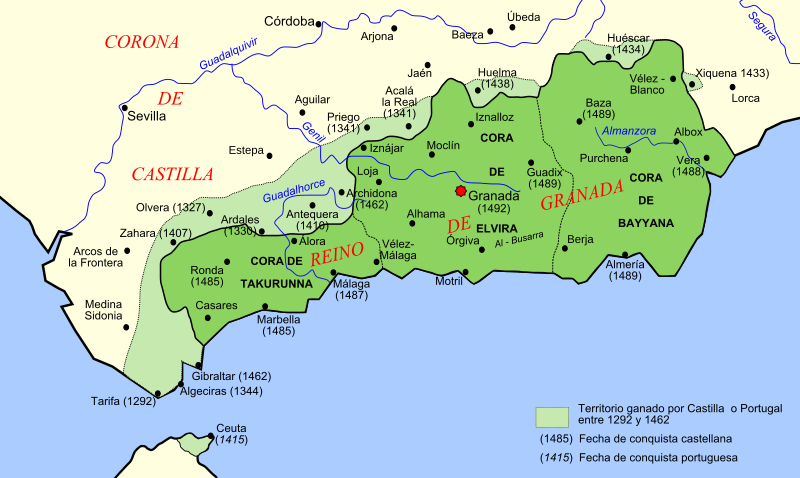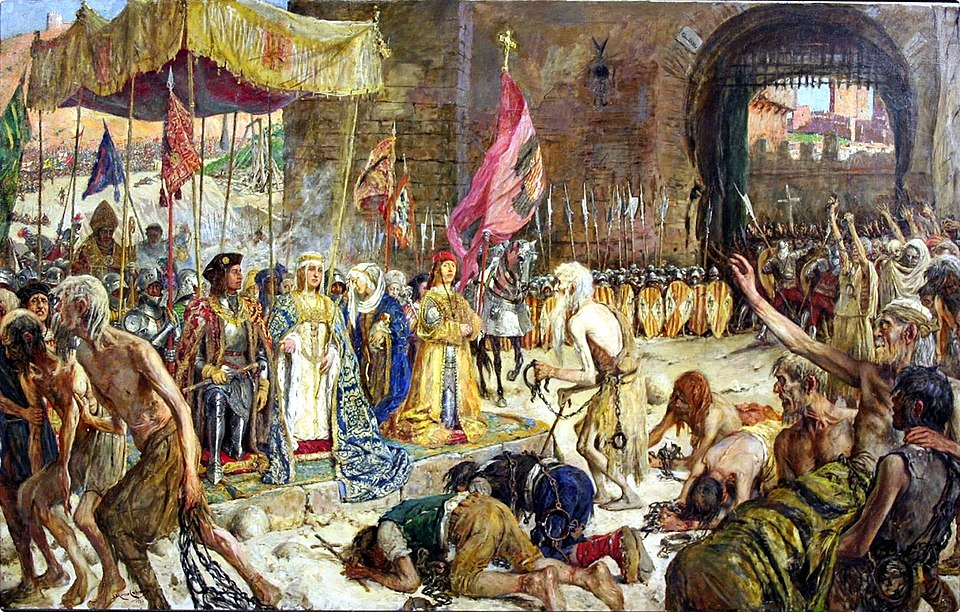IB Syllabus focus:
'A detailed chronology of the Granada War, highlighting key battles, strategies, and political maneuvers.
The role of prominent figures on both sides of the conflict.
The impact of the war on the populace and the territory of Granada.'
The Granada War (1482-1492) epitomised the last chapter of the Reconquista, the arduous Christian pursuit to reclaim the Iberian Peninsula from Muslim rule. The fall of Granada marked the end of the Nasrid dynasty and the unification of Spain under Catholic rule.

Map of the Nasrid Emirate of Granada with major towns and capture dates, including those central to the 1482–1492 campaign (Ronda 1485, Marbella 1485, Málaga 1487, Baza 1489, Granada 1492). Some earlier conquests elsewhere on the peninsula are also shown for context beyond the syllabus period. Source
Chronology of the Granada War
1482: Onset of Hostilities
Siege of Alhama: Initiated by the Christian forces, the strategic capture of Alhama, close to the capital city of Granada, was pivotal.
Tactical Importance: Its geographic location enabled control over key transportation routes.
Muslim Response: Nasrid forces repeatedly, but unsuccessfully, attempted to recapture Alhama in a series of counter-sieges.
1483: Escalation and Key Engagements
Siege of Loja: Christian forces attempted to take the fortress-town of Loja. Despite initial success, they met stiff resistance and eventually retreated.
Battle of Axarquía: Positioned in the mountainous region east of Malaga, this was a decisive Muslim victory, providing a morale boost for the beleaguered Nasrid forces.
1485: The Christian Advancement
Capture of Ronda: The Christians undertook a prolonged siege against Ronda. Its fall was vital due to its protective position for the approach to Granada.
Mountainous Advantage: Its elevated position provided strategic oversight over the surrounding regions.
Siege of Marbella: Successfully overtaken by the Christian forces, the port city's capture further restricted Granada’s maritime access, crippling their naval capabilities.
1487: The Strategic Triumph
Siege of Malaga: One of the most intense episodes of the war. Lasting for over three months, Malaga was a significant naval and trade hub for the Nasrid kingdom. Its loss severely affected both the economy and the defence mechanisms of Granada.

José Moreno Carbonero’s depiction of the Catholic Monarchs freeing captives after the 1487 fall of Málaga underscores the siege’s human and political consequences. The image reinforces Málaga’s strategic importance and the consolidation of Christian control along the coast. Source
1489: Attrition and Persistence
Siege of Baza: Located in the northeast of Granada, Baza’s siege spanned several months, with both sides facing exhaustion. Eventually, the town capitulated, further narrowing down the Nasrid territory.
1491-1492: The Final Showdown
Siege of Granada: In what would be the last major engagement, the Christian forces gradually encircled Granada, strategically isolating it.
2nd January 1492: After protracted negotiations, the Nasrids formally surrendered Granada, bringing an end to Muslim sovereignty in the Iberian Peninsula.
Prominent Figures of the Conflict
Christian Leadership:
Ferdinand II of Aragon
Strategic Genius: Beyond direct military engagement, he adeptly handled diplomatic channels, securing vital alliances to strengthen the Christian position.
Resource Management: Ensured consistent supply chains, keeping the army well-equipped and morale high.
Isabella I of Castile
Stabiliser: Her influence quelled internal Christian disputes, focusing energies on the Reconquista.
Patron: Commissioned various chronicles of the war, ensuring that the Christian narrative was well-documented for posterity.
Nasrid Command:
Muhammad XII (Boabdil)
Diplomatic Endeavours: Early in the war, he sought alliances with the Christians to counter internal Nasrid adversaries.
Turbulent Reign: Repeatedly challenged by factions within Granada, his reign was characterised by political instability.
El Zagal, Muhammad XIII
Counter-Leader: He consistently challenged Boabdil's authority, carving a separate domain in Almería.
Resilient Defence: Recognised for his tenacity, he staunchly resisted Christian advances at key locations like Almería.
Aftermath and Implications for Granada
Population and Displacement
Human Cost: Direct combat, disease, and famine led to significant casualties.
Migration Patterns: Post-war, there was a notable emigration of Muslims and Jews. They sought refuge in North Africa and the Ottoman territories, foreseeing stringent Catholic policies.
Territorial Reorganisation
Land Ownership: The victorious Christian monarchs redistributed Muslim-owned lands among Spanish nobility and loyal military commanders.
Urban Transformation: Many Muslim architectural marvels were preserved, but several mosques were converted into churches.
Socio-Cultural Dynamics
Religious Transition: A deliberate policy of Christianisation began, eroding the Islamic fabric of the region.
Language Evolution: With the political change, Castilian Spanish started to overshadow Arabic, reshaping the linguistic landscape of Granada.
The Granada War not only heralded the end of an era in Iberian history but also catalysed Spain’s emergence as a preeminent global power. The ensuing decades saw a Spain unified in faith and purpose, poised to embark on ventures like the discovery of the Americas.
FAQ
The Granada War, with its decade-long sieges and guerilla-style warfare, offered valuable lessons for Spanish military leadership. Tactics honed during this conflict, such as siege warfare, the use of artillery, and the combination of cavalry with infantry, were later employed in European theatres. The emphasis on intelligence, logistics, and supply chain management during the Granada War became staples of Spanish military doctrine. Moreover, the experience of integrating diverse forces – ranging from mercenaries to allied troops – into a cohesive fighting unit was invaluable, especially as Spain's influence expanded in Europe and the New World.
The diverse geographical landscape of the Iberian Peninsula, encompassing mountains, plateaus, and coastal areas, played a pivotal role in shaping military strategies. For instance, fortresses in mountainous regions, like Ronda, offered strategic oversight and defensive advantages, making their sieges prolonged and arduous. Conversely, coastal cities like Malaga held naval importance, prompting considerable effort to control maritime access. The intricate network of valleys and passes necessitated astute planning for troop movements. Overall, the topographical complexity demanded that both sides adapt their strategies continuously, making geographical acumen as crucial as martial might.
Indeed, the Granada War saw the effective use of certain military technologies that influenced its course. The Christians, for example, deployed heavy artillery and cannons with greater efficacy than in previous conflicts. These tools proved invaluable in breaching fortified walls, hastening the fall of many Nasrid strongholds. Additionally, advancements in fortification designs, inspired by the Italian Renaissance, began to be integrated, offering better protection against the evolving artillery threats. While the Nasrids also employed artillery, they couldn't match the scale or effectiveness of the Christian forces, further tilting the balance of power towards the latter.
Both the Christian and Muslim sides sought external allies to bolster their respective positions. The Christian monarchs, for instance, sought alliances with other European kingdoms, aiming to strengthen their military might and secure crucial resources. Additionally, the Papacy's support offered spiritual legitimacy to the Christian campaign. On the Muslim side, though efforts were made to solicit assistance from North African Muslim states, these were largely ineffectual. The Maghreb kingdoms had their own regional concerns, limiting their aid to the beleaguered Nasrid kingdom. The stark contrast in the efficacy of these external alliances undoubtedly influenced the trajectory of the conflict, giving the Christian forces an edge.
The Nasrid dynasty was plagued by internal conflicts, particularly between Boabdil (Muhammad XII) and his uncle, El Zagal (Muhammad XIII). Boabdil's tumultuous reign, characterised by multiple imprisonments and releases, saw him occasionally collaborate with the Christians in hopes of countering threats from rivals like El Zagal. In contrast, El Zagal maintained staunch resistance against the Christians. This internal division severely undermined the unity and strategy of the Nasrid defence. As a result, instead of presenting a united front against the advancing Christian forces, the Nasrid kingdom was embroiled in power struggles, which expedited its downfall.
Practice Questions
The Siege of Alhama in 1482 was pivotal due to its proximity to Granada, granting the Christians a strategic foothold in enemy territory. Its capture signalled a firm Christian intent, simultaneously challenging the Nasrid dynasty's stronghold. Equally crucial was the Siege of Malaga in 1487. As a bustling trade and naval hub for the Nasrid kingdom, Malaga's fall not only disrupted Granada's economic dynamics but also rendered a significant blow to their defence capabilities. Both engagements, strategically spaced across the duration of the war, consistently eroded the Muslim defence, eventually culminating in the surrender of Granada.
Ferdinand II of Aragon exhibited a multifaceted leadership style, combining astute military strategy with adept diplomatic negotiations. His ability to secure essential alliances and manage resources ensured that the Christian forces were consistently in an advantageous position. Conversely, Muhammad XII, often known as Boabdil, faced a turbulent reign, marked by both external pressures from the Christian onslaught and internal strife within the Nasrid dynasty. His initial attempts at diplomacy with the Christians, aiming to quell internal adversaries, later backfired. The juxtaposition of Ferdinand's assertive and united leadership with Boabdil's fragmented reign undeniably tilted the scales, contributing significantly to the Christian victory in the Granada War.

